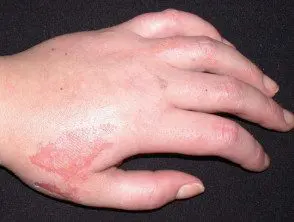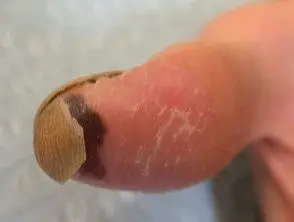What is a chemical burn?
Chemical burn is a burn to the internal or external organs of the body caused by a corrosive or caustic chemical substance that is a strong acid or base (also known as alkali). Chemical burns are usually the result of an accident and can occur at home, at school, or, more commonly, at work, particularly in manufacturing plants that use large amounts of chemicals.
Very minor chemical burns cause irritating Contact dermatitis. The chemical burn from a strong acid or alkali is also known as a caustic burn.
What causes a chemical burn?
The main cause of chemical burn is contact with strong acids or bases.
- The strength of acids and bases is defined by the pH scale, which ranges between 1 and 14.
- A very strong acid has a pH of 1 and can cause a severe burn.
- A very strong base has a pH of 14 and can also cause a severe burn.
- A substance with a pH of 7 is considered neutral and does not burn.
common acids
Sulfuric acid: concentration varies from 8% to almost pure acid
- toilet cleaners
- Drain cleaners
- metal cleaners
- car battery fluid
- Fertilizer manufacturing
Nitric acid
- Used in engraving, metal refining, electroplating and fertilizer manufacturing.
Hydrofluoric acid: a weak acid and in dilute form it does not burn or cause pain on contact
- rust removers
- Tire cleaners
- Tile cleaners
- glass engraving
- dental work
- Refrigerant
Hydrochloric acid: concentrations range between 5 and 44%
- toilet cleaners
- metal cleaners
- Pool cleaners
- Manufacture of dyes
- Metal refining
phosphoric acid
- metal cleaners
- rust proof
- Disinfectants, detergents
- Fertilizer manufacturing
Common bases
Sodium hydroxide and potassium hydroxide, depending on the concentration, can be very corrosive.
- Drain cleaners
- oven cleaners
- Denture Cleaners
Sodium and calcium hypochlorite
- Bleach
- Pool chlorination solution
Ammonia
- Cleaners and detergents used in diluted form are not highly corrosive
- Anhydrous gaseous ammonia used in the manufacture of fertilizers can cause serious burns.
Phosphates
- Many household detergents and cleaners
What are the signs and symptoms of a chemical burn?
The signs and symptoms of a chemical burn depend on several factors, including:
- Agent pH
- Agent concentration.
- Duration of contact time
- Amount of agent involved
- Physical form of the agent (i.e.: solid, Liquid gas)
- Contact site (e.g., eyes, skin, mucous membrane)
- Whether swallowed or inhaled
- Whether or not the skin is intact.
Ingesting a solid pill of an alkaline substance highlights the importance of these factors. The solid sediment stays in the stomach for a longer period, therefore, more severe burns occur. Another important factor is that the concentrated forms of some acids and bases generate a large amount of heat when diluted; This results in a thermal burn as well as a chemical burn.
Some signs and symptoms of chemical burns include:
- Redness, irritation, or burning at the contact site.
- Pain or numbness at the contact site.
- Formation of black dead skin (it's expensive) – this occurs particularly with acid chemical burns as they produce a coagulation necrosis denaturing proteins
- Deep tissue injury to the skin is caused by alkaline chemical burns, as they produce liquefaction necrosis involving protein denaturation and fat saponification.
- Changes in vision or complete loss of vision if chemicals get into the eyes.
Chemical burns

Unknown cause

24 hours after fluoride burning

10 days after fluoride burning
In severe chemical burns where the agent has been swallowed, inhaled, or absorbed into the bloodstream, the following systemic Symptoms may occur.
- Cough or shortness of breath
- Low blood pressure
- Weakness, weakness, dizziness.
- Headache
- Muscle spasms or convulsions
- Cardiac arrest or irregular heartbeat.
What is the management of a chemical burn?
Basic first aid should be administered as soon as a chemical burn occurs.
- Remove contaminated clothing
- Irrigate the affected area with large amounts of water. Wash for at least 20 minutes, taking care not to allow runoff to contact unaffected areas. Irrigation received within 10 minutes of the burn has been shown to reduce wound severity and hospital stay.
Chemical burns involving elemental metals (lithium, potassium, sodium, and magnesium) should not be irrigated with water, as this can cause a chemical reaction that makes the burns worse. These types of chemical burns should be soaked with mineral oil while awaiting medical attention.
People with mild chemical burns do not require hospitalization. For more severe burns, patients should be treated as for a typical thermal burn patient. In some situations, an antidote may be administered to counteract the offending chemical agent. For example, hydrofluoric acid burns should be treated promptly with calcium gluconate. gel applied every 15 minutes, so the gel must be kept at the relevant work sites.
The main goals of treatment for treating burn wounds are:
- Carefully monitor the wound
- Keep wounds clean
- Prevent the wound from drying out
- Manage secondary infection.
Commonly used current antibacterials include silver sulfadiazine 1% cream, Silver nitrate solution at 0.5% and mafenide acetate cream at 10%.

